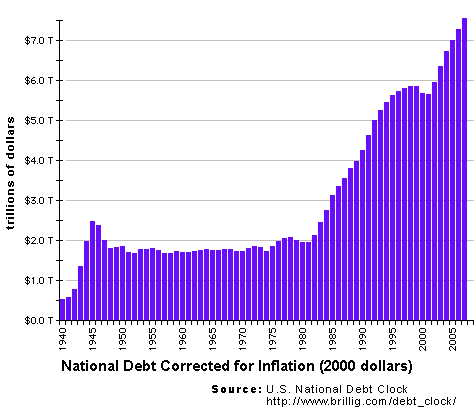NEW YORK (AP) -- A watched clock never moves -- unless it's the National Debt Clock.
In fact, the digital counter has been moving so much that it recently ran out of digits to display the ballooning figure: $10,150,603,734,720, or roughly $10.2 trillion, as of Saturday afternoon.
The clock was put up by the late real estate mogul Seymour Durst in 1989 when the U.S. government's debt was a mere $2.7 trillion, and was even turned off during the 1990s when the debt decreased.
It will be replaced in 2009 with a new clock, said Jordan Barowitz, a spokesman for the Durst Organization. The new clock will be able to track debt up to a quadrillion dollars, which is a '1' followed by 15 zeros.
In the meantime, the '1' from "$10.2" has been moved left to the LCD square once occupied solely by the digital dollar sign. A non-digital, improvised dollar sign has been pasted next to the '1.'
The current clock had enough digits to measure the amount of money owed by the U.S. government until debt recently hit $10 trillion. Since then, more eyes have been on the fixture near touristy Times Square.
When Nancy Gurzo spotted the sign one recent afternoon, she came to a halt. Standing in the middle of the sidewalk, Gurzo pointed up at the sign, gesturing for her daughter, son-in-law and three grandchildren, all of whom had left her behind, to walk back and see.
"It's a shame," the 60-year-old Manasquan, New Jersey, restaurant manager said, anger and disbelief in her face. "It's an absolute outrage. It may be the end of the United States as we know it today. We haven't seen the worst of it. Everybody should stop and look at this clock. It affects all of us. I'm worried."
That afternoon, others glanced at the clock, some of their faces wrinkling with confusion. But most pedestrians seemed not to even notice the clock, which is tucked several stories high on the side of a brick parking garage-office building.
The counter, on West 44th Street near Sixth Avenue, is more visible to those walking west; for those walking east, the sign is already behind them once they walk by the building.
On a shaded block of Broadway theaters, restaurants and high-end retailers, the clock isn't the most striking sight. Below the clock is a midtown office for the Internal Revenue Service, and at the nearby intersection stands an Ameritrade investment office and a Chase bank branch.
Svet Stauber paused in front of the sign and held his camera up to snap a picture of a key measure of the U.S. economy.
"It's symbolic," Stauber, a 40-year-old pilot from Switzerland, said of the counter's lack of space. "It's a very big symbol. It's a complete failure of the system. It's the most powerful country in the world with a conservative government for the last eight years, and it's running the biggest debt ever."
The reaction of Stauber's wife, Roberta, to the escalating debt was more pointed: "It's good for the United States," the doctor said, adding that maybe the country's current predicament would deflate its "ego" and "arrogance."
"You think you are the best country in the world," she continued. "I hope America reflects about this."
Kary Perez, an 18-year-old freshman at Rutgers University, said, "I think it's sad how bad we've fallen as a nation," as she watched the clock, which features images of $1 bills in the background.
Below the amount of the national debt on the clock is another row of figures: "YOUR Family share." As of Saturday afternoon, the $86,023 fit properly into the respective LCD squares.





 anyway.
anyway.


